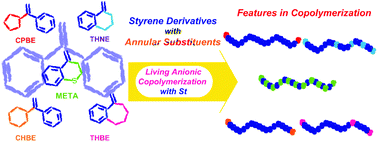Investigation of the features in living anionic polymerization with styrene derivatives containing annular substituents†
Abstract
Five styrene derivatives with annular substituents (SAs), called (1-cyclopentylvinyl)benzene (CPBE), (1-cyclohexylvinyl)benzene (CHBE), 1-methylene-1,2,3,4-tetrahydronaphthalene (THNE), 5-methylene-6,7,8,9-tetrahydro-5H-benzo[7]annulene (THBE) and 4-methylenethiochromane (META), were successfully synthesized and living anionic polymerization was conducted. Among these SAs, CPBE and CHBE possessed dissociative cycloparaffins as the α-substituent in the styrene structure, while THNE and THBE exhibited vinyl-substituted benzo-cycloalkanes. Additionally, the META monomer showed a similar structure to that of THNE, but with a sulfur atom in the benzo-cycloalkane. Due to the presence of bulky cyclic structures in these molecules, similar non-homopolymerization characteristics, such as is the case of 1,1-diphenylethylene (DPE) derivatives, were discovered during living anionic polymerization (LAP). Thus, the living anionic copolymerization of these SAs with styrene (St) was performed to investigate their specific features. All of the copolymers exhibited narrow polydispersity, without any unexpected side-reaction over multiple variations in the reaction conditions. The investigations of their features in living anionic copolymerization of these five SAs showed that CPBE and CHBE were difficult to incorporate into chains, THNE and THBE exhibited relatively higher reactivity than the above two, while META presented the highest reactivity (rSt = 2.6) among the five SAs. Meanwhile, density functional theoretical (DFT) calculations were used to simulate the optimal structures of these SAs and to theoretically understand the differences in their reactivity. Based on the actual results of the specific features of the SAs, it is possible to explore new monomers for further synthesis of sequence-controlled polymers using the living anionic polymerization strategy. Furthermore, this new insight into a monomer synthetic strategy can be expanded for subsequent sequence control and tailoring of the polymer properties.



 Please wait while we load your content...
Please wait while we load your content...